Task statement
Before turning to mathematical reasoning, it is worth mentioning that, of course, I am not the first to think about this issue at all. On the Internet you can find a sufficient number of articles and even news stories of federal channels on this topic. However, each time the essence of this kind of experiment consists in the usual run down the escalator with the subsequent comparison of the time gained with the time of the person standing on the escalator. Slightly better if the authors are trying to assess the effectiveness of downhill. Even better if they still provide statistics. For statistics, by the way, I’ll say a special thank you a little lower. In connection with the lack of clarity of these experiments and the lack of practical conclusions, I was conceived, and subsequently carried out, an analysis of the ongoing process.
And so, we formulate the conditions of the problem and denote the restrictions:
- The experiment (mental) involves two people who approach the escalator at the same time at a random moment in time and have no idea where the train is.
- One of these people is standing on an escalator and spending time on a descent.
equal to the time of movement of the escalator.
- The second accelerates down the escalator, increasing its speed in
times, thereby reducing the descent time by the same number of times:
.
- Effective is considered such an accelerated descent, which led to the fact that the person standing on the escalator does not have time to board the train, in which the person running on the escalator has time to board.
- Denote by
- the probability of an effective descent. Then, according to the Nash equilibrium, a person is ready to take a chance and run down the escalator only if the probability of an effective descent is greater than or equal to the probability of an ineffective descent or stop in place, i.e. 0.5. If the probability of an effective descent is greater than or equal to 0.5, the decision to run down the escalator will be called appropriate . If less than 0.5 - impractical .
- We neglect the fact that in real life, as a rule, it is necessary to go some further distance to the car after leaving the escalator or to wait for people to leave the car, trains go at variable intervals and stand motionless for a while before opening and after closing the doors, that is, we will assume that if at the moment of leaving the escalator the train is at the station, then its doors are open and the experiment participant instantly ends up in the car, the train itself opens (closes) the doors and arrives (leaves) to the station (from the station) instantly and dnomomentno.
Decision progress
Let's draw the time axis (Fig. 1). The entire axis will be consecutive intervals between trains. Hereinafter, only one interval will be considered. Divide the interval shown into 4 equal segments. Point 0 on this axis corresponds to the moment the train leaves the station. Point 3 corresponds to the arrival of the train and the opening of the doors. Point 4 - closing the doors and departure of the train. Thus, for the convenience of graphical representation and calculations, the interval between trains is counted between the moments of departure of trains from the station. The first 3 segments are the time passengers are forced to wait for the arriving train. The fourth segment is the train’s stopping time, when passengers can board it. Put also that time
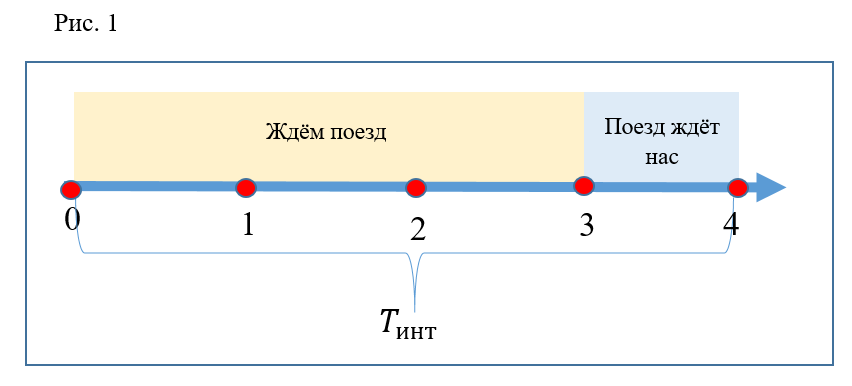
Now, to determine the probability

Consider another case (Fig. 3): the participants in the experiment approach the escalator at time 2. As in the previous case, the first will be on the platform at time
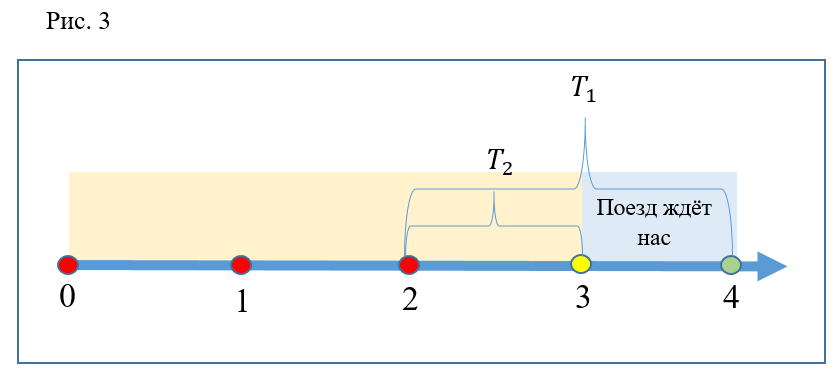
Further, it is easy to understand that at any time in the interval from 2 to 3, running downhill is effective, since the escaped person always manages to board the train, and not the escaped one. If you choose time points between 3 and 4, then both participants are late for the train and are forced to wait for the next one together, that is, running again is ineffective.
It turns out that out of 4 conventional time periods, it is effective to run down only if the participants approach the escalator between 2 and 3 times (Fig. 4). The probability of getting into it is 1/4. Consequently, under the given conditions of the task, the decision to run down is impractical, since the second participant is more likely (with a probability of 3/4) to run in vain and will be forced to wait for the train along with the first, who came down later.

The following remarks will be completely fair:
- Intervals between trains can both decrease and increase. The parking time may increase, and the waiting time may decrease (with the same interval) and vice versa.
- The speed of the escalator down is constant, but the descent time can vary, since the stations can be more or less deep.
- The second participant may well run not 2, but 3 or even 4 times faster than the escalator.
To assess the impact of changes in the above factors, it is necessary to derive the relationship between these values and the probability of getting on the escalator at a time when it is effective to run down.
To do this, we will depict another case (Fig. 5). Leave all the original data unchanged with the exception of one: coefficient

Based on Figure 4 and Figure 5, it is obvious that the length of the “effective” segment is
We perform a series of transformations:
The final formula:
Based on this formula, several fundamental conclusions can be drawn at once:
- The probability value is not affected by changes in the stopping time and train waiting unless the total interval is changed (Fig. 6).
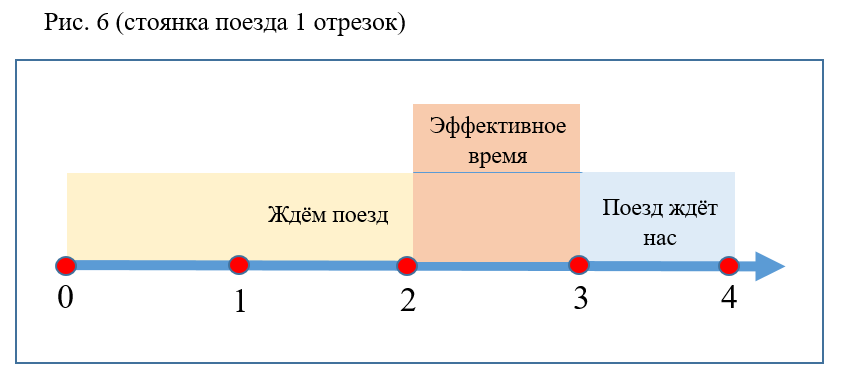

- The larger the interval between trains, the lower the probability P (Fig. 7).
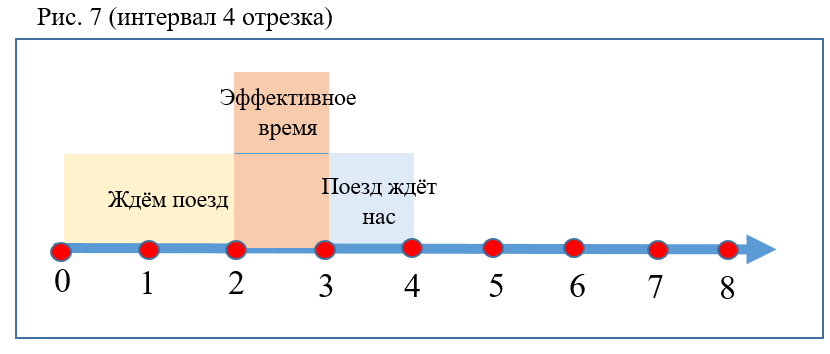

- The probability increases if the ratio of the descent time on the escalator to the interval and / or the coefficient K increases.
Fidelity check
Now let's see how true the derived formula is?
To verify the correctness of the formula, we turn to the statistics, which were very handy back in 2014 by The Village correspondent. I express my recognition and, naturally, at the end of the article I will leave a link to the original article. It’s also good that the statistics are presented as visual infographics.
Experiment 1. Metro station Chekhovskaya
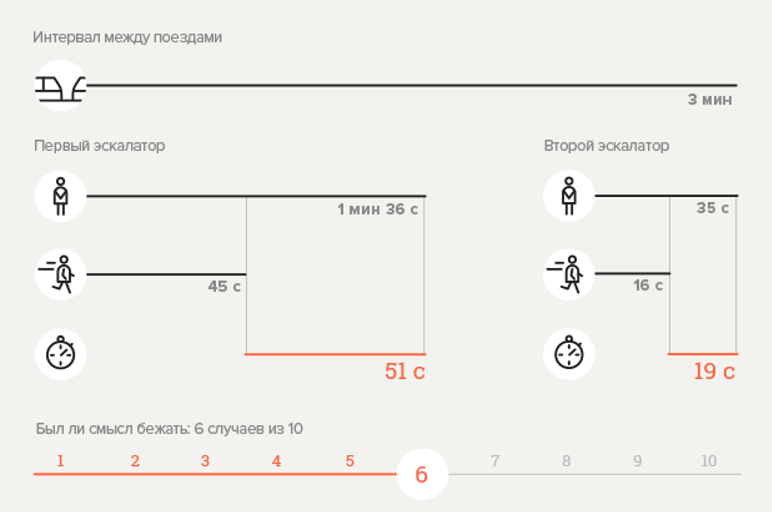
Calculate the probability
Here
The result obtained, as can be seen, diverges from the experimental data. Is the formula wrong? Not! It can be seen from the infographic that the descent to the station involves a trip on two escalators, however, the transition time between them is not taken into account. If, for reliability, we assume that the transition takes at least 30 seconds, then, substituting a new value
Experiment 2. Metro station "Victory Park"
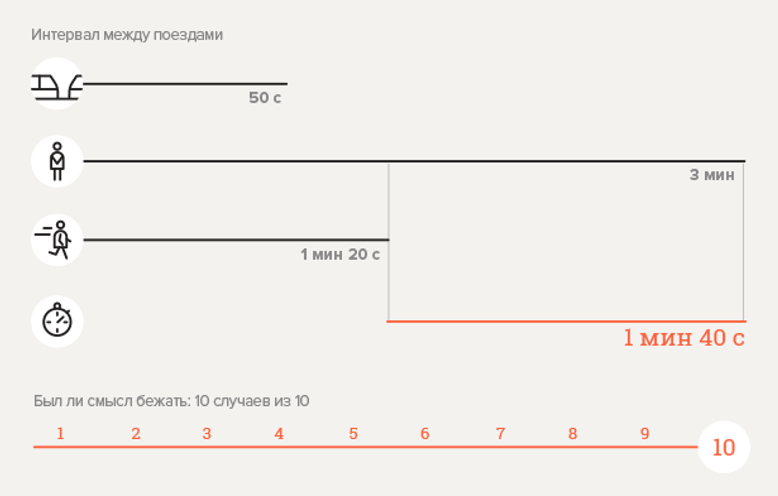
Calculate the probability
Here
It can be seen that we got a probability greater than one. But there is no contradiction here. If you look at the general form of the formula, it becomes obvious that in the case when the descent time on the escalator is equal to the interval between trains, then an increase in speed by at least 2 times will make the probability that accelerated descent is effective equal to 0.5. If the travel time of the escalator is greater than the interval, then with the same coefficient
Experiment 3. Park Kultury metro station

Calculate the probability
Here
Error again? Not at all. It can be seen that, as stated above, the descent time on the escalator is 2 times the interval between trains. Running time is 2 times less. It turns out that every descent should be effective. But do not forget that before starting the discussion we made the assumption regarding the instantaneous closing of doors and at least the instantaneous departure of the train from the station. If you imagine such an option as in Figure 8, it becomes clear that in real life a runaway person may not have time to sit down at point 1 (for example, the train will leave a little earlier) and at point 2 the train, on the contrary, will delay a bit, and then the non-running person will sit in it with the late-running person who was late for the previous train.
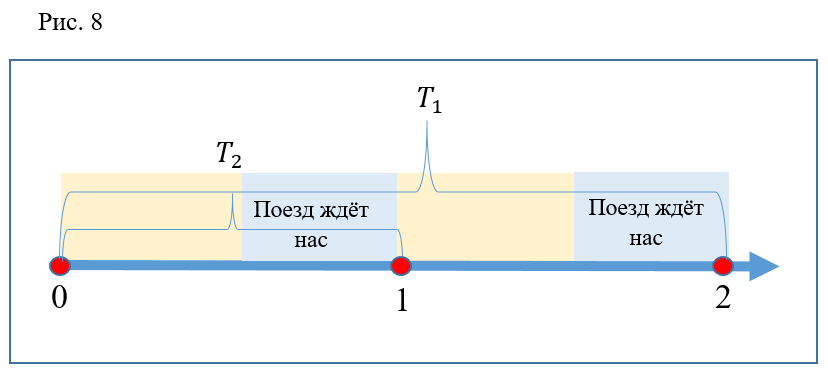
I suppose that in both "ineffective" times it happened. There is every reason to argue that with an increase in the number of repetitions of the experiment, the percentage of "effective" runs will tend to 100%.
conclusions
Now that, based on the available experimental data, it was possible to confirm the correctness of the formula, we will analyze it and draw conclusions. Since at the very beginning we agreed that we would consider the decision to run downward expedient if the probability of an effective descent is greater than or equal to 0.5. That is, literally, if we can be sure that at least in half the cases we will run for good reason, then it is really worth taking the risk and running, because if we are late, we will practically lose nothing. Based on the foregoing, we rewrite the probability formula as follows:
It is interesting that, as we have already found out, it makes sense to always run when
Now let's take a look at the speed of the correspondent. On average, it is about 2 times the speed of the escalator (descent time is 2 times less). In general, these data coincide with the results of my own experiments (I don’t see the point of bringing them). As a rule, developing speed for which the K coefficient would be at least 3 is already difficult: on a real escalator there are many who want to run down and, moreover, people standing on their left or their things (bags, suitcases) may interfere. Means
PS Please take into account the fact that this task does not take into account the need to get into a specific carriage. It is only about getting on the platform and then boarding the train.
Experimental data source: The Village . Thanks again!